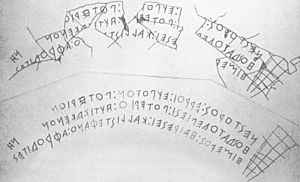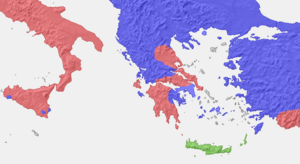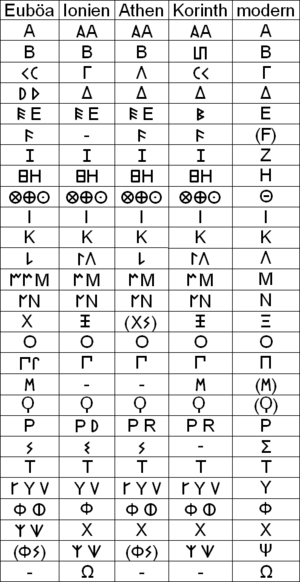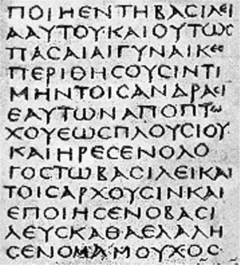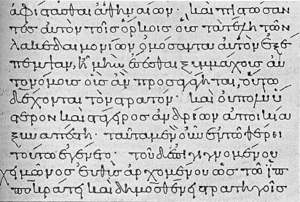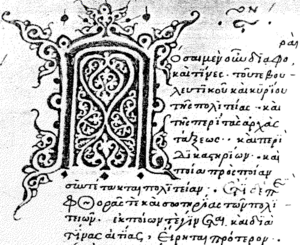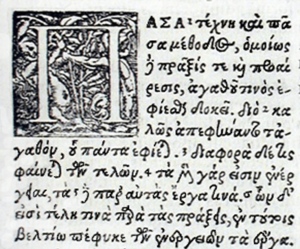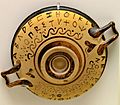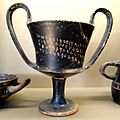History of the Greek alphabet facts for kids
The history of the Greek alphabet is a fascinating journey that shows how writing changed over thousands of years! It all started when ancient Greeks borrowed letters from the Phoenician alphabet around the 9th or 8th century BC. This happened during a time called Archaic Greece.
Before this, the Greeks used a different writing system called Linear B. But that system was lost after a big collapse in the Late Bronze Age and a period known as the Greek Dark Age. The new Greek alphabet was a big step forward because it was the first to have separate letters for both consonants and vowels. This made it much easier to read and write than older systems.
The Phoenician alphabet mainly used letters for consonant sounds. But Greek needed vowels too! So, the Greeks cleverly took some Phoenician letters that represented sounds they didn't have and turned them into vowels. For example, the Phoenician letter 'aleph' became the Greek 'alpha' (A).
This new Greek alphabet didn't just stay in Greece. It traveled east to Phrygia, where a similar writing system was created. It also went west with traders from Euboea. The Etruscans in Italy then used the Greek alphabet for their language. This eventually led to the creation of the Latin alphabet, which is what English and many other languages use today!
Contents
- When Did Greeks Start Using the Alphabet?
- How the Phoenician Alphabet Changed for Greek
- Different Greek Alphabets (Epichoric Alphabets)
- New Letters Added to the Alphabet
- The Standard Greek Alphabet (Ionic)
- How Greek Writing Changed Over Time
- Names of the Greek Letters
- Greek Numerals
- How the Greek Alphabet Spread
- Images for kids
When Did Greeks Start Using the Alphabet?
Most experts believe the Greeks started using the Phoenician alphabet in the early 8th century BC. This might have happened on the island of Euboea. The very first pieces of Greek writing we've found are from around 770–750 BC. Their letter shapes look a lot like Phoenician letters from that same time.
The oldest complete texts we know of are the Dipylon inscription and the writing on the Cup of Nestor. Both are from the late 8th century BC. They are simple messages, like who owned the item or who it was given to a god.
Some old stories say that a daughter of King Agamemnon of Aeolian Cyme married a Phrygian king named Midas. This connection might have helped the Greeks get their alphabet from the Phrygians, as the Phrygian letters look very similar to those found in Aeolis.
Some researchers think the alphabet was adopted even earlier, but these ideas are not widely accepted. An alphabet found on Cyprus, called the Fayum alphabet, seems to be older than other early Greek writings. It's from around 800 BC. This could mean the alphabet was first adapted on Cyprus, where Phoenicians had a big settlement. However, the local Cypriot writing system was still used there for a long time.
Another idea is that the alphabet was adapted on the island of Thera. The ancient historian Herodotus said Phoenicians settled there early on. But archaeologists haven't found proof of a Phoenician presence on Thera.
What Did Herodotus Say About the Alphabet?
The ancient Greek historian Herodotus told a famous story about how the alphabet came to Greece. He said a Phoenician named Cadmus brought it:
The Phoenicians who came with Cadmus introduced writing to Greece. Before that, Greeks didn't know how to write. At first, the Phoenicians used the same letters as other Phoenicians. But over time, as their language changed, so did the shape of their letters. Most Greeks nearby were Ionians. They learned these letters from the Phoenicians and used them, changing them a little. They kept calling them "Phoenician characters" because that's where they came from. I have seen cauldrons in a temple in Thebes with writing on them in Cadmean characters. They look a lot like Ionian letters.
Herodotus thought Cadmus lived about 2000 BC. He described seeing old writing on tripods (three-legged stands) in a temple. He said these writings were from the time of Laius, who was Cadmus's great-grandson. One tripod had an inscription that said, "Amphitryon dedicated me from the spoils of Teleboae." Another said, "Scaeus the boxer, victorious, dedicated me to Apollo, the archer god."
Other Ancient Stories About Writing
Hyginus, another ancient writer, had a different story. He said the three Fates (goddesses of destiny) created the first five vowels and the letters B and T. He also said that Palamedes invented eleven more consonants. Then, Hermes (the messenger god) turned these sounds into wedge-shaped characters, like how cranes fly. He supposedly brought this system from Greece to Egypt. This was called the Pelasgian alphabet.
Hyginus added that Cadmus later brought this alphabet to Boeotia. Then, Evander brought it to Italy, and his mother, Carmenta, created the fifteen letters of the Latin alphabet from it.
Diodorus Siculus, another Greek historian, disagreed that Phoenicians invented letters. He thought they just "changed the form and shape" of older letters. He said, "The Phoenicians were not the first to invent letters, but only changed their form and shape. Many people later used the name 'Phoenician letters' because of this."
Plutarch, a Greek writer, also questioned Herodotus's stories. He and other ancient writers gave credit to the legendary Palamedes for adding new letters that weren't in the original Phoenician alphabet. The idea of using separate letters for long and short 'e' (Eta and Epsilon) and long and short 'o' (Omega and Omicron) was traditionally credited to Simonides of Ceos.
Plutarch even talked about an older Greek writing system, which he said was like Egyptian writing. He described a Spartan king, Agesilaus, finding an ancient writing on a bronze plate. Agesilaus sent it to Egypt to be translated. This suggests that ancient Egyptians were good at translating different languages. The famous Rosetta Stone is a great example of this, as it has the same text written in three different scripts!
How the Phoenician Alphabet Changed for Greek
| Phoenician | Greek | ||
|---|---|---|---|
| 𐤀 | ʼāleph | Α | alpha |
| 𐤁 | bēth | Β | beta |
| 𐤂 | gīmel | Γ | gamma |
| 𐤃 | dāleth | Δ | delta |
| 𐤄 | hē | Ε | epsilon |
| 𐤅 | wāw | Ϝ | digamma |
| Υ | upsilon | ||
| 𐤆 | zayin | Ζ | zeta |
| 𐤇 | ḥēth | Η | eta |
| 𐤈 | ṭēth | Θ | theta |
| 𐤉 | yōdh | Ι | iota |
| 𐤊 | kaph | Κ | kappa |
| 𐤋 | lāmedh | Λ | lambda |
| 𐤌 | mēm | Μ | mu |
| 𐤍 | nun | Ν | nu |
| 𐤎 | sāmekh | Ξ | xi |
| 𐤏 | ʿayin | Ο | omicron |
| 𐤐 | pē | Π | pi |
| 𐤑 | ṣādē | Ϻ | san |
| 𐤒 | qōph | Ϙ | qoppa |
| 𐤓 | rēš | Ρ | rho |
| 𐤔 | šin | Σ | sigma |
| 𐤕 | tāw | Τ | tau |
| Φ | phi | ||
| Χ | chi | ||
| Ψ | psi | ||
| Ω | omega | ||
Most Phoenician letters were used in Greek with similar sounds. But Phoenician had some "guttural" sounds (made in the throat) that Greek didn't have. The Greeks cleverly used these extra Phoenician letters to represent their vowels.
For example, the Phoenician letters 'ʼāleph', 'hē', and 'ʽayin' became the Greek vowels alpha (A), e (E), and o (O). This was a big deal because it meant Greek could write all its vowel sounds clearly!
Phoenician also had letters like 'wāw' and 'yōdh' that could be used for both consonant and vowel sounds. In Greek, 'yōdh' became the vowel iota (I). The letter 'wāw' was used in two ways: as the consonant digamma (like 'W') and as the vowel upsilon (U). Upsilon was added at the end of the alphabet so it wouldn't mess up the order of letters used for numbers.
All Phoenician letters had names that started with the sound they made (like 'Bēth' for 'B'). This idea was kept in Greek, even for the new vowel letters. For example, 'ʼāleph' became 'alpha' (A), and 'hē' became 'epsilon' (E).
The Phoenician alphabet had three letters for 's' sounds, but Greek only needed one. So, the Greeks used some of these letters for their 's' sound, and others for new sounds like 'ks' (Xi) and 'ps' (Psi).
Different Greek Alphabets (Epichoric Alphabets)
Between the 8th and 6th centuries BC, different parts of Greece developed their own slightly different versions of the alphabet. These are called epichoric alphabets. They are usually grouped into three main types:
- Green (like on Crete)
- Red (Euboean or Western)
- Blue (Ionic, Attic, and Corinthian)
The main differences were in the extra letters they added to the basic Phoenician set. For example, some added letters for sounds like 'ph' (Φ), 'kh' (Χ), or 'ps' (Ψ).
New Letters Added to the Alphabet
Greek needed more letters for certain sounds, especially for 'p' and 'k' sounds that had a puff of air (aspirated sounds), and for combinations like 'ks' and 'ps'. Different Greek regions used different symbols for these.
For example:
- The 'kh' sound could be written as Κ, ΚΗ, Ψ, or Χ.
- The 'ph' sound could be written as Π, ΠΗ, or Φ.
- The 'ks' sound could be written as ΚΣ, ΧΣ, Χ, or Ξ.
- The 'ps' sound could be written as ΠΣ, ΦΣ, or Ψ.
Greek also had both short and long vowel sounds, but only five vowel letters. Over time, they started using the letter Eta (Η) for the long 'e' sound. A new letter, omega (Ω), was created for the long 'o' sound. Omega was probably made by adding a line under the letter omicron (Ο).
The Standard Greek Alphabet (Ionic)
In 403/2 BC, after a big war, the city of Athens decided to change its old alphabet. They chose to use a standard version of the eastern Ionic alphabet. This new, official alphabet was called the Euclidean alphabet.
This was a very important step because it made sure all vowels could be written clearly. It was the first "true" alphabet with separate letters for all vowels and consonants. This Ionic alphabet eventually spread across the entire Greek-speaking world.
The Ionic alphabet added the new letter omega (Ω) at the very end. It also made the way different sounds were written much more consistent.
Here's how some sounds changed from the old Attic alphabet to the Ionic:
| Sound | Old Attic | Ionic |
|---|---|---|
| 'h' sound | Η | (no symbol) |
| Long 'e' sound | Ε | Η (eta) |
| Long 'o' sound | Ο | Ω (omega) |
| 'kh' sound | Χ | Χ (chi) |
| 'ph' sound | Φ | Φ (phi) |
| 'ks' sound | ΧΣ | Ξ (xi) |
| 'ps' sound | ΦΣ | Ψ (psi) |
Later, around 200 BC, a system of special marks called diacritics was invented. These marks showed the tone accents in Ancient Greek. They also sometimes helped show if a vowel was long or short. This system of accents and punctuation marks is credited to Aristophanes of Byzantium.
How Greek Writing Changed Over Time
During ancient times and the early Byzantine period, two main styles of handwriting developed. One was called uncial script. It used large, upright letters, much like the capital letters we see today. This was used for important books.
For everyday writing, like letters or documents, a cursive script was used. This had slanted, connected letters and many shortcuts.
From the mid-9th century AD, a new style called Greek minuscule replaced uncial script for books. This style used smaller, rounder letters and was partly based on the earlier cursive. This made writing books faster and more compact.
With minuscule writing, Greeks also started using spaces between words and special marks (like accents) more regularly. Punctuation marks also began to appear.
In medieval books, old uncial (capital) letters were sometimes mixed with minuscule (small) letters for titles or to start a word. This is how the idea of letter case (uppercase and lowercase letters) began in modern writing. Our modern capital letters come from uncial script, and our small letters come from minuscule script.
When printing was invented, the way Greek letters looked became more fixed. Early printers tried to copy the beautiful handwriting of Greek scribes, creating a style similar to modern italics. Since Greece was under Ottoman rule for a long time, most early Greek printers were in Western Europe. This meant that printing styles for Greek were influenced by Latin printing. Over time, the cursive-inspired Greek print changed to a more upright style, like Latin print.
In 1982, modern Greek officially adopted a simpler writing system called monotonic orthography. This removed some old accent marks and breathings that were no longer needed because the sounds they represented had changed or disappeared.
Names of the Greek Letters
The names of some Greek letters were changed over time to make them clearer, especially when certain vowel sounds merged.
| Letter | Original name | Later name | Why the name changed |
|---|---|---|---|
| Ε | ei | epsilon | "Plain e" to tell it apart from another sound that also sounded like 'e'. |
| Ϝ | probably wau | digamma | "Double gamma" because it looked like two gamma letters stacked. Its sound was forgotten. |
| Ο | o or ou | omicron | "Small o" to tell it apart from the long 'o' sound. |
| Υ | u | upsilon | "Plain u" to tell it apart from another sound that also sounded like 'u'. |
| Ω | ō | omega | "Large o" to tell it apart from the short 'o' sound. |
| Ϡ | sampi | "Like pi" because of its shape. Its sound was forgotten. |
Greek Numerals
The letters of the Greek alphabet were also used as numbers. For this, some letters that were no longer used in everyday writing, like digamma (Ϝ) and qoppa (Ϙ), were kept just for numbers. A rare letter called sampi (Ϡ) was also added at the end for numerical purposes.
How the Greek Alphabet Spread
The Old Italic alphabet (used in ancient Italy) and the Anatolian alphabets (used in parts of modern-day Turkey) also appeared around the 8th century BC. These alphabets got their start from the Euboean version of the Greek script, which was different from the Ionic alphabet we use today.
Images for kids
-
Dedication in Boeotian alphabet on a black-glaze Boeotian kantharos.


